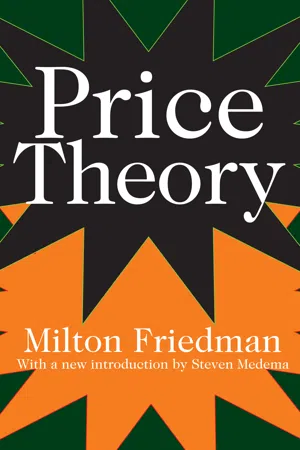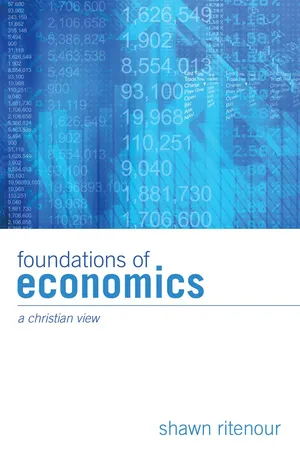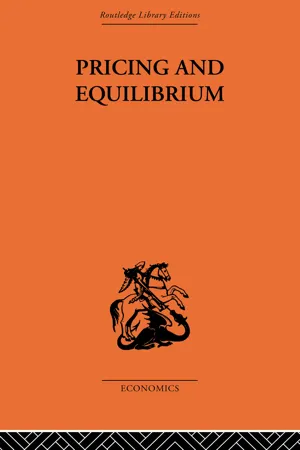Economics
Factor Demand Curve
The factor demand curve represents the relationship between the quantity of a factor of production, such as labor or capital, and the price of that factor. It illustrates how the quantity of the factor demanded by firms changes as the price of the factor changes, holding other factors constant. The factor demand curve slopes downward due to the law of diminishing marginal returns.
Written by Perlego with AI-assistance
Related key terms
9 Key excerpts on "Factor Demand Curve"
- eBook - ePub
- Milton Friedman(Author)
- 2017(Publication Date)
- Routledge(Publisher)
In the main, the marginal productivity theory is a way of organizing the considerations that are relevant to the demand for a factor of production. It has some, but not very much, substantive content. This is reflected in our ability to speak of an abstract factor of production—factors A or B, etc.—without having to specify it any further. To say that wages are equal to the value of the marginal product, for example, says relatively little in and of itself. Its function is rather to suggest what to look for in further analysis. The value of the marginal product is not a single number determined by forces outside the control of individuals or society; it is rather a schedule or function of many variables. It will depend on the quality and quantity of workers, the quantity of capital they have to work with, the quality of the management organizing their activities, the institutional structure of the markets in which they are hired and the product sold, etc. In concrete applications, the basic substantive issue is likely to be what determines the marginal productivity and how the changes under consideration will affect it.The analysis of the demand for factors of production is closely related to the analysis of the supply of products, and, indeed, is really only another way of looking at or organizing the same material. In analyzing the supply curve of a product, we are interested in tracing the effect of changes in the demand for it under given conditions on the factor markets. In consequence, we direct attention to the output of the firm or industry and take for granted the changes in the quantity of the various factors of production employed and in their prices as demand for the product and with it output of the product change. In distribution theory, our interest centers in the factor markets, and so we concentrate attention on a different facet of the same adjustment by the firm. To put it differently, the statement that a firm seeks to equate marginal factor cost to marginal value product is another way of saying that it seeks to equate marginal revenue to marginal cost rather than an additional condition on the equilibrium of the firm.As in the theory of supply of products, there are several different levels of analysis, and the demand curve will change as we shift our point of view from the reactions of the firm to the reactions of an industry. And in this case, there is also a third level that is significant, the economy as a whole, since many different industries may employ what for any particular problem it is useful to regard as a single factor of production.The demand curve for a factor of production by a particular group of demanders (which may as a special case be a single firm) shows the maximum quantity of the factor that will be purchased by the group per unit of time at each price of the factor, for given conditions. As in previous problems, there is some uncertainty how it is best to specify the “given conditions.” They clearly include (1) technical knowledge—the “state of the arts” or the production functions of actual and potential firms; and (2) the conditions of demand for the final producst. The uncertainty attaches primarily to the handling of other factors of production. One procedure is to take as given (3) the supply curves of other factors of production to the group of demanders considered. The problem with item 3 is that at least for the economy as a whole, constant supply curves for other factors may mean an increase in the total resources of the community as we move along the demand curve for this factor in response to an increase in its supply. The alternative is to take the “total resources” of the community, appropriately defined, as fixed, and thus to regard changes in the supply of this factor as changes in its supply relative to other factors but not in the total resources of the community. We shall for the most part beg this question, since most of our discussion wold be unaffected by its resolution. - eBook - ePub
Microeconomics
A Global Text
- Judy Whitehead(Author)
- 2014(Publication Date)
- Routledge(Publisher)
Using this knowledge, a producer, with adequate knowledge of the production function (technology) and the market (price or marginal revenue information) knows how to achieve profit maximization. This could mean the difference between survival in a market or extinction, or between great success in a market or marginal survival. Knowledge of the rules of the games gives a greater chance of success so vital to producers facing greater global competition.14.4 Market Demand for a Single Input
14.4.1 The market demand curve for labour under perfect competition
From the single producer to the market
In making the transition from the factor demand of the single producer/firm to the factor demand of the market, the major consideration is that: The Factor Demand Curves for the individual producers (firms) cannot be summed to find market demand for a factor of production .This is the primary difference between the construction of the market demand for a good and that for a factor of production. This difference derives from the nature of the demand for a factor input where that demand is described as a derived demand . It has previously been shown that the demand for a factor of production is derived from the marginal physical productivity of that factor and the price (or marginal revenue) of the product it produces (VMPLorMRPL).In moving from the short-run (single variable factor) to the long-run (several variable factors) factor demand, there are shifts in demand due to the effect on the marginal physical productivity of the factor. In moving from the individual producer to the market, there are also shifts in the demand curve for a factor, this time because of the effect on the price (or marginal revenue) of the product produced by the factor.The shift in the factor’s demand curve occurs because, in the total market, the changes in the factor input’s price affect the use of the factor, the level of output and hence, the price of the product - eBook - ePub
Foundations of Economics
A Christian View
- Ritenour(Author)
- 2010(Publication Date)
- Wipf and Stock(Publisher)
Remember that the demand curve represents the maximum price buyers will pay for any given quantity of a good. We have seen that the maximum price a producer would be willing to pay for the use of a specific quantity of a factor is that factor’s DMRP. Consequently, a factor’s DMRP curve can be viewed as the demand curve for that factor. We find, then, that an individual producer’s demand for the service of a factor is determined by three things: The marginal productivity of the factor or its MPP, the price for which the producer can sell her output, and social time preference which determines the interest rate.Demand for Factors of Production:From Individuals to the MarketRecall from chapter 4 that the market demand for a good is the sum of the quantities demanded by all buyers at each hypothetical price. Likewise, the market supply of a good is the sum of the quantities all sellers are willing to sell at each hypothetical price. For factors of production that are not specific to a production process, meaning they can be used in other lines of production, there are many entrepreneurs that can make use of their services. For example, many more than one firm or even industry make use of janitors or administrative assistants or assembly line workers. Every firm that uses their services is a demander of their labor. Of course, the many, many people who are willing to work as janitors, administrative assistants, assembly line workers, or college professors are suppliers of such labor.In order to derive the market demand for a particular factor of production, we need to consider the other producers besides Cecily who want to make use of sewing machines in their operations. These other producers use their respective production functions to determine the MPP of machines for them. They also use their MPP calculations in conjunction with the estimated market price of the good they are selling to derive the MRP of sewing machines for them. They likewise discount their MRP for machines by the interest rate in deriving the DMRP of sewing machines in their operations. Their MPP, MRP, and DMRP schedules and curve manifest all of the same properties as they did for Cecily. - eBook - ePub
- Erich Schneider(Author)
- 2013(Publication Date)
- Routledge(Publisher)
With given prices for the factors, the minimum average variable cost will be where the average product of the variable factor (DEF) reaches its maximum, that is, in Fig. 94, at a level of output OL. We have shown earlier (Fig. 44) that the maximum for the average product of a variable factor lies on the marginal product curve. The firm will only demand any of the variable factor if its price is not greater than the value of the marginal product of the quantity OL of the factor. This proposition is simply another way of stating that the individual supply curve begins from the point of minimum average variable cost. The demand curve of the firm for the variable factor will, therefore, be given by the section HQW of the falling part of the curve of the value of the marginal product. 2. Up to now we have assumed that the firm behaves as a quantity-adjuster in selling the product it makes. We now want to study how our previous reasoning about the firm’s demand for the factors is affected, if the firm is confronted by an expected price–sales function. It was shown previously that on the assumption that the firm is striving for maximum total profit it will decide to sell that quantity at which marginal revenue and marginal cost are equal. But we now know that for every minimum cost combination of factors, the marginal product of a substitute factor multiplied by the marginal cost is equal to the price of this factor. Taking account of the fact that at the Cournot point marginal cost and marginal revenue are equal, it follows that the level of output corresponding to the Cournot point must satisfy the equation: where (MP) i is the marginal product of the i th substitute factor, MR is the marginal revenue, and q i the price of the factor. This relationship gives us the quantity of the factor demanded by the firm at each price for the factor. It represents the demand function of the firm for the i th substitute factor - eBook - ePub
Deciphering Economics
Timely Topics Explained
- David E. O'Connor(Author)
- 2014(Publication Date)
- Greenwood(Publisher)
law of demand , there is an inverse relationship between price and quantity demanded. That is, if the price of a good increases, the quantity demanded will decrease. Conversely, if the price of a good decreases, the quantity demanded will increase.To construct an initial demand curve for a product, economists employ the ceteris paribus assumption. Under the ceteris paribus assumption, all external factors that might affect the demand for the product, except price, are temporarily held constant. In the product market, the demand curve typically represents the viewpoint of the consumer, who buys final goods or services from businesses. In the factor market, the demand curve typically represents the viewpoint of the producer, who buys resources from households.The demand curve shown in Figure 2.4 represents the demand for product X at a moment in time. Hence, a change in the price of product X causes a change in the quantity demanded , not a change in the overall demand for the product. Speaking precisely, economists say that a change in price causes a movement along an existing demand curve. In Figure 2.4 , for example, if the price of product X decreases from $6 to $4, there is a downward movement along the existing demand curve. In this case, the $2 decrease in price caused the quantity demanded to increase from 6,000 items to 8,000 items but had no impact on the overall demand for product X. Note that a change in price does not cause the demand curve to shift to the right or to the left.Changes in Demand
How does a change in the overall demand for a good occur? To change the demand for a good, the ceteris paribus assumption is lifted, allowing other factors, called determinants of demand, to enter the picture. A change in one or more of the determinants of demand causes buyers to want more or less of a good at each and every price. There are six main determinants of demand: people’s tastes and preferences, income level, market size, price of substitute goods, price of complementary goods, and expectations. - eBook - ePub
- Enrico Colombatto(Author)
- 2016(Publication Date)
- Routledge(Publisher)
To summarise, demand depends on the satisfaction generated by X (the subjective value of X) and on the sacrifices one has to make in order to acquire X (the opportunity cost of X). In particular, the negative slope of the curve is due to the crucial – but plausible – assumption according to which the lower the sacrifice required to obtain X, the greater one's willingness to have more of it.2.3 Demand curves are imaginary and partial
Simple as the above might sound, some caution is, however, necessary. To begin with, the reader will surely recall that all the price–quantity intersections described by the demand schedule depicted in Figure 2.1 refer to the combinations that match Alicia's ideal, from which Alicia has no incentive to deviate. To repeat, the demand schedule is developed by imagining that an individual goes to a hypothetical market place as a price taker and faces a seller asking him: ‘how much X would you buy if the price was P0 ? And how much would you buy at P1 ? And at P2 ?’ Each of the answers given by Alicia identifies one point in a space defined by quantity and prices. Finally, by connecting all the points, one obtains the demand curve for good X. Crucial to understanding the demand schedule/curve, however, is the fact that those points relate to contexts in which Alicia ends up being content with her situation and indifferent between buying more and buying less of X. Economists typically characterise this situation as ‘equilibrium’, and claim it explains why the demand schedule can definitely be portrayed as a locus of ideal/optimal choices (or of equilibrium). If this condition of indifference did not apply, Alicia would ask for a greater or smaller quantity of X at each price quoted by the prospective seller.Yet, this is an imperfect world and human beings are imperfect creatures. In other words, individuals rarely consume the set of goods and services that maximises their satisfaction. They often lack the necessary knowledge or have biased information, sometimes because gathering information is expensive and takes too much time, sometimes because human beings lack the skill to process it or simply because they make decisions without paying too much attention (preferences may be vague and ill-defined). Hence, they make mistakes. Moreover, their preferences change with tastes, fashions and imitation; new products show up and old products are discarded. The upshot is that one should not put too much faith in demand curves: they are ideal situations that characterise omniscient individuals in a static world. But individuals seldom operate in these ideal conditions and hardly make the ‘optimal’ decisions. - No longer available |Learn more
Contemporary Economics
An Applications Approach
- Robert Carbaugh(Author)
- 2016(Publication Date)
- Routledge(Publisher)
- A market is a mechanism through which buyers and sellers communicate in order to trade goods and services. Through the price system, markets link potential buyers with potential sellers.
- Demand is a schedule that shows the amount of a good or service that buyers are willing and able to purchase at each possible price during a particular period. A demand curve is a graphical representation of the data comprised by a demand schedule. A movement along a demand curve, resulting from a change in price, is called a change in quantity demanded.
- According to the law of demand, price and quantity demanded are inversely related, assuming that all other factors affecting the quantity demanded remain the same. Economists explain the law of demand in terms of the substitution effect, the income effect, and the principle of diminishing marginal utility.
- A demand shifter is a variable that causes a shift in a demand curve. Among the most important demand shifters are consumer tastes, the number of buyers, consumer income, the prices of related goods, and expected future prices. When a demand shifter causes an increase in demand, the demand curve shifts to the right; a decrease in demand causes the demand curve to shift to the left.
- Supply is a schedule or curve showing the amounts of a good or service that firms or households are willing and able to sell at various prices during a particular period. The quantity supplied refers to a single point on a supply curve. Changes in quantity supplied are caused by changes in the price of the product.
- According to the law of supply, sellers are willing and able to make more of their product available at a higher price than a lower price, all other determinants of supply being constant. The tendency for the cost of additional output to increase explains the law of supply.
- A supply shifter is a variable that causes a shift in a supply curve. Among the major supply shifters are resource prices, technology, the prices of other goods, expected future prices, taxes and subsidies, and the number of suppliers. When a supply shifter results in an increase in supply, the supply curve shifts to the right; a decrease in supply shifts the supply curve to the left.
- eBook - ePub
- Murray N(Author)
- 2014(Publication Date)
- Editorial Bubok Publishing(Publisher)
A typical single firm is considered, with its selling prices and prices of factors given. Then, the proportions of the factors are assumed to be variable. It can be shown, accordingly, that if the price of factor A increases compared to B, the firm will use less of A and more of B in producing its product. From this, demand curves for each factor are deduced, and the pricing of each factor established. The fallacies of this approach are numerous. The chief error is that of basing a causal explanation of factor pricing on the assumption of given factor prices. On the contrary, we cannot explain factor prices while assuming them as given from the very beginning of the analysis. 1 It is then assumed that the price of a factor changes. But how can such a change take place? In the market there are no uncaused changes. It is true that this is the way the market looks to a typical firm. But concentration on a single firm and the reaction of its owner is not the appropriate route to the theory of production; on the contrary, it is likely to be misleading, as in this case. In the current literature, this preoccupation with the single firm rather than with the interrelatedness of firms in the economy has led to the erection of a vastly complicated and largely valueless edifice of production theory. The entire discussion of variable and fixed proportions is really technological rather than economic, and this fact should have alerted those writers who rely on variability as the key to their explanation of pricing. 2 The one technological conclusion that we know purely from praxeology is the law of returns, derived at the beginning of chapter 1. According to the law of returns, there is an optimum of proportions of factors, given other factors, in the production of any given product. This optimum may be the only proportion at which the good can be produced, or it may be one of many proportions. The former is the case of fixed proportions, the latter of variable proportions - eBook - ePub
Microeconomic Theory second edition
Concepts and Connections
- Michael Wetzstein(Author)
- 2013(Publication Date)
- Routledge(Publisher)
The price at which a factor is just willing supply is called the reservation price. A firm will employ the profit-maximizing level of a variable input where the VMP of the input is set equal to its price. This corresponds to the tangency of the isoprofit line with the production function. For one variable input, the VMP curve is the firm's demand curve for the input. For two or more inputs, the VMP functions are solved simultaneously for the input demand functions. A perfectly competitive input market is characterized by many buyers and sellers of an input. Each firm can buy (hire) all the inputs it wants at the market price (wage). Each supplier of the input can offer as much of the input it wants at the given price (wage). (Appendix) The total effect of an input price change may be decomposed into the substitution and output effects. The substitution effect measures a change in the level of an input given a change in its price, holding output constant. The output effect is the change in level of an input when the output changes as a result of a change in the input price. (Appendix) The minimum wage is a price floor below which the wage rate cannot fall. If the minimum wage is below the equilibrium wage rate, it has no effect on the market. However, if it is set above this equilibrium wage rate, it will influence the market level of the input
Index pages curate the most relevant extracts from our library of academic textbooks. They’ve been created using an in-house natural language model (NLM), each adding context and meaning to key research topics.








